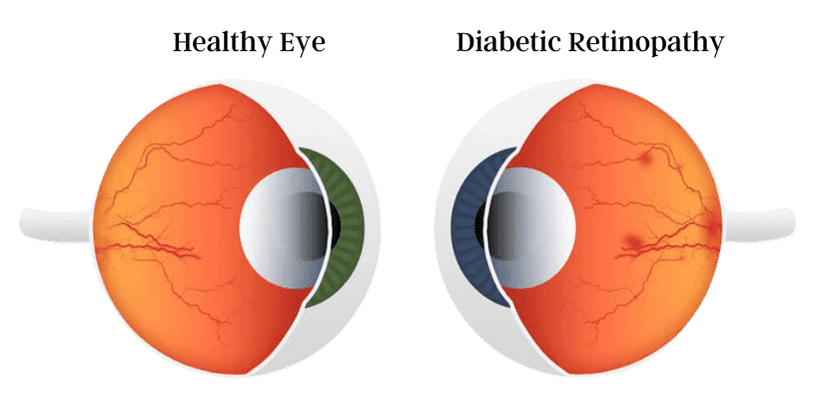Diabetic Retinopathy is an Eye disorder that can happen when a person has diabetes. It affects the eyes and can lead to Blindness. It occurs when the blood vessels in Retina, the light-sensitive layer in the Eye’s Interior, get damaged by high blood sugar levels.
Diabetic Retinopathy usually affects both eyes. It can happen slowly over time, and you may not notice any symptoms in the early stages. However, it is the leading cause of Blindness in adults who can work. Early diagnosis and treatment can help keep people from losing their Eyesight.
When to see an eye doctor? (Consulting a Retina Specialist)
See an eye doctor immediately if you have symptoms like blurred vision, floaters, or flashes of light, particularly if you have diabetes. Those patients having already diabetic Retinopathy should periodically consult a Retina Specialist or Vitro Retinal surgeon to monitor any sudden changes. Getting treatment right away is essential to keep from losing sight.
CAUSE: Why does Diabetic Retinopathy happen?
No one knows for sure why this happens, but it is thought to be caused by factors like oxidative stress, inflammation, and changes in the blood vessels themselves. Diabetes can lead to diabetic Retinopathy, which damages the blood vessels in the retina. The retina layers towards the back of the human eye sense light and help send visual signals to the brain. High blood sugar levels among diabetic patients damage the retina’s blood vessels, making them leak or rupture completely, leading to diabetic Retinopathy. If not treated for a long time, this can lead to partial or total Blindness.

SYMPTOMS: What are the Symptoms of Diabetic Retinopathy? (Signs of Diabetic Retinopathy)
During the early stages of diabetic Retinopathy, there may be no symptoms that you can pick or see. But as the disease progresses, some common signs include:
- Blurred Eyesight
- Seeing spots or floating objects
- Difficulty in seeing during Night or dark
- Double vision
- Trouble seeing colors
- Blind spots in the line of sight.
Note: Patients with diabetes need regular eye examinations to diagnose diabetic Retinopathy early and safeguard their Eyesight.
PREVENTION: Is the Prevention of Diabetic Retinopathy possible?
Yes, diabetic Retinopathy can be prevented or slowed by
- Keeping blood sugar levels under control
- Getting regular eye exams
- Living a healthy lifestyle
- Taking care of your blood pressure (hypertension)
- Treating any signs or symptoms as soon as you notice them.
But it’s important to remember that diabetic Retinopathy can still get worse, even if the disease is well managed. Hence early detection and treatment can help slow the disease’s progress and save your vision.

TREATMENT: What is the best treatment for Diabetic Retinopathy?
Treatment depends on how early the disease is picked up by your Retina Specialist The Sooner the detection, the better the chances of successful treatment. Hence the line and procedure of treatments for diabetic Retinopathy depend on how bad it is and the stage of its detection.
- At the early stages, diabetic Retinopathy can be slowed down at the early stages by having regular eye exams and controlling your blood sugar levels.
- Mild to moderate non-proliferative diabetic Retinopathy (NPDR): There may be no need for treatment, but keeping a close eye on the condition is essential.
- Severe NPDR: Laser surgery (photocoagulation) can seal blood vessels that are leaking and prevent more vision loss.
- Proliferative Diabetic Retinopathy (PDR): Laser surgery, injections of medicine (anti-VEGF therapy), or vitrectomy may be used to treat it (removal of the vitreous gel inside the eye).
Diabetes and diabetic retinopathy can cause vision loss, so it’s crucial to catch them early and treat them immediately. Because of this, people with diabetes need regular eye exams by an eye care professional.
DIAGNOSIS: How to detect Diabetic Retinopathy?

Diabetic Retinopathy is usually detected during a comprehensive dilated eye exam, which includes a thorough look at the retina, the blood vessels that supply it, and the optic nerve. These tests can be used to find out if someone has diabetic Retinopathy:
- Exam with the pupil widened: Your eye doctor will dilate the pupil and look at the retina for signs of damage.
- Fundus photography: A special camera is used to take a picture of the back of the Eye.
- Optical coherence tomography (OCT): This is a non-invasive test that uses light waves to make detailed pictures of the retina.
- Fluorescein angiography: A special dye is injected into the arm, and pictures of the retina are taken as the dye moves through the blood vessels.
Early detection is critical for successful treatment. If treated early, diabetic Retinopathy can be slowed down, and vision can be saved. Therefore, people with diabetes should get complete eye exams regularly to check for changes or signs of diabetic Retinopathy.

